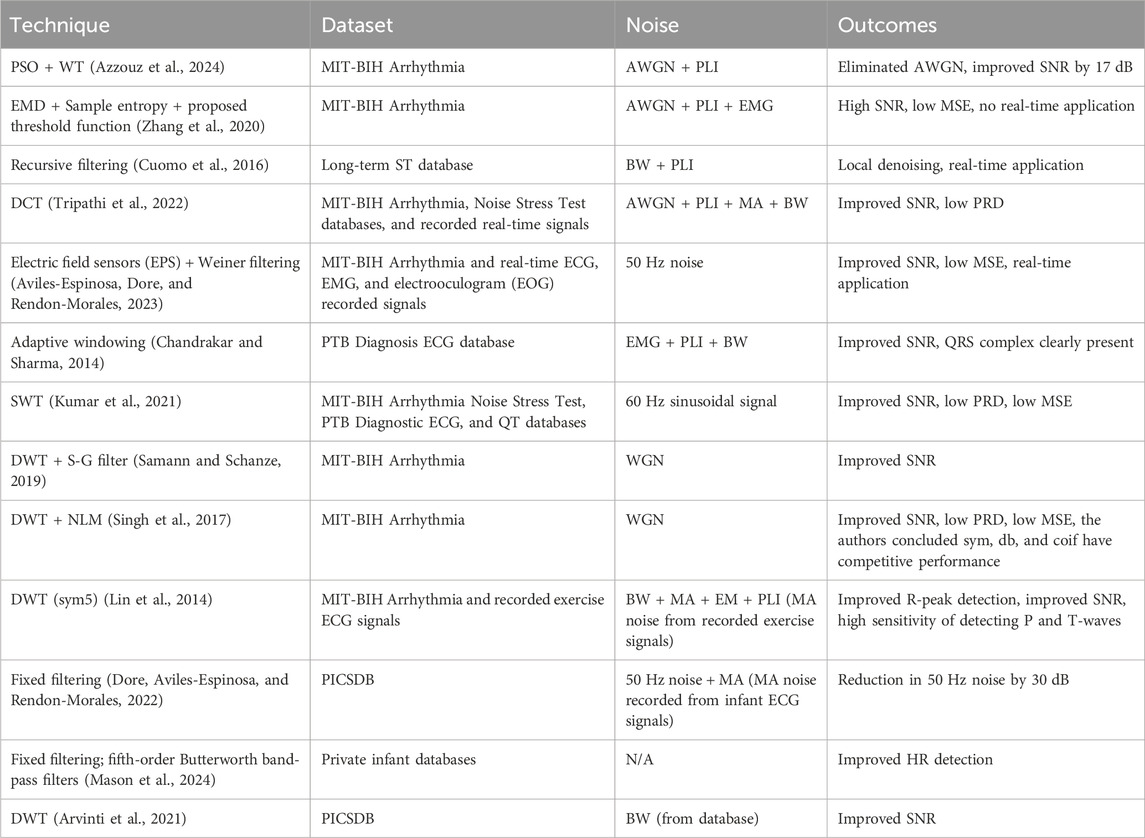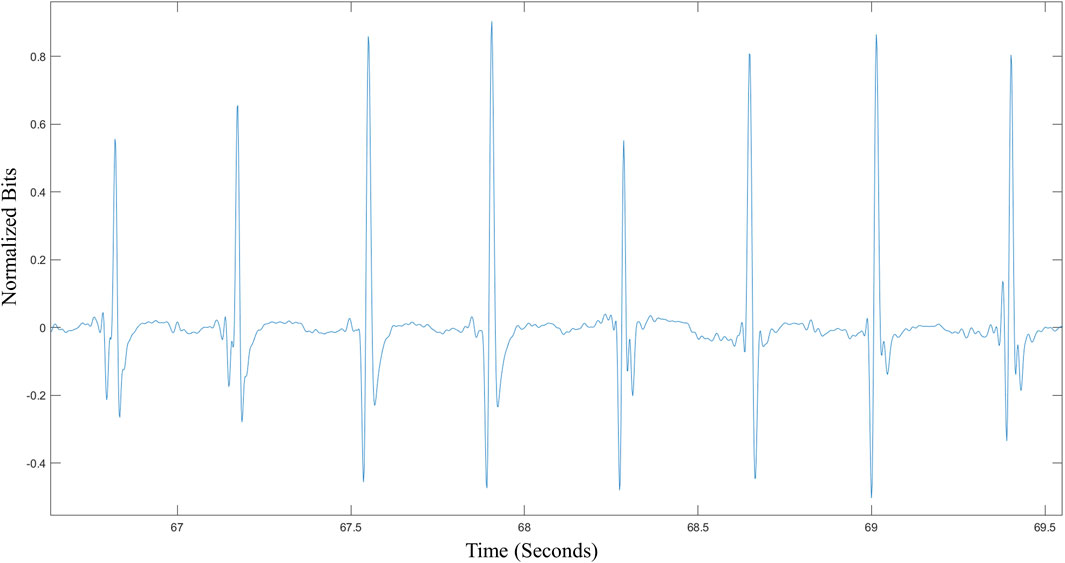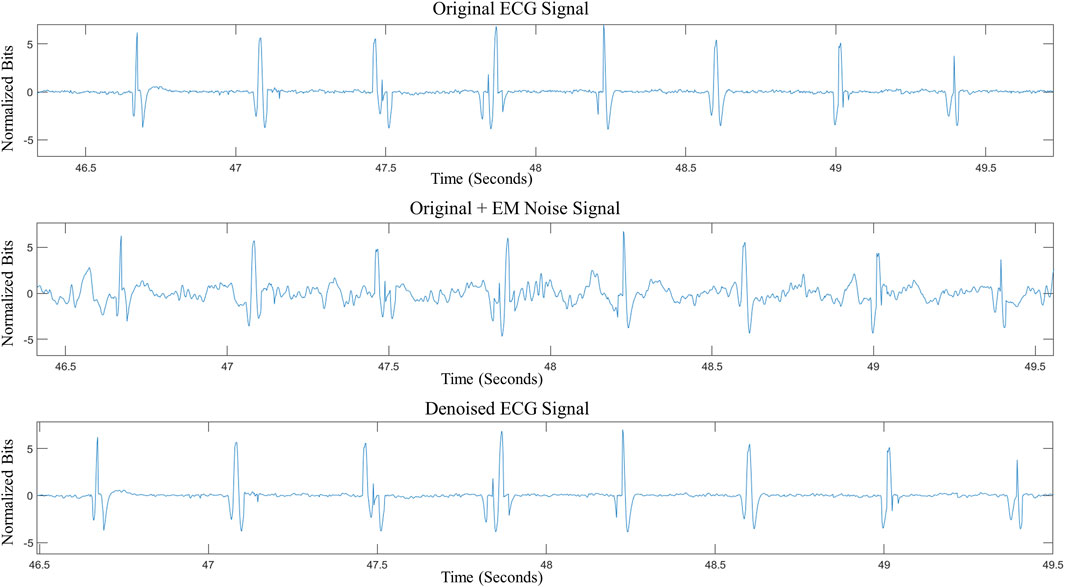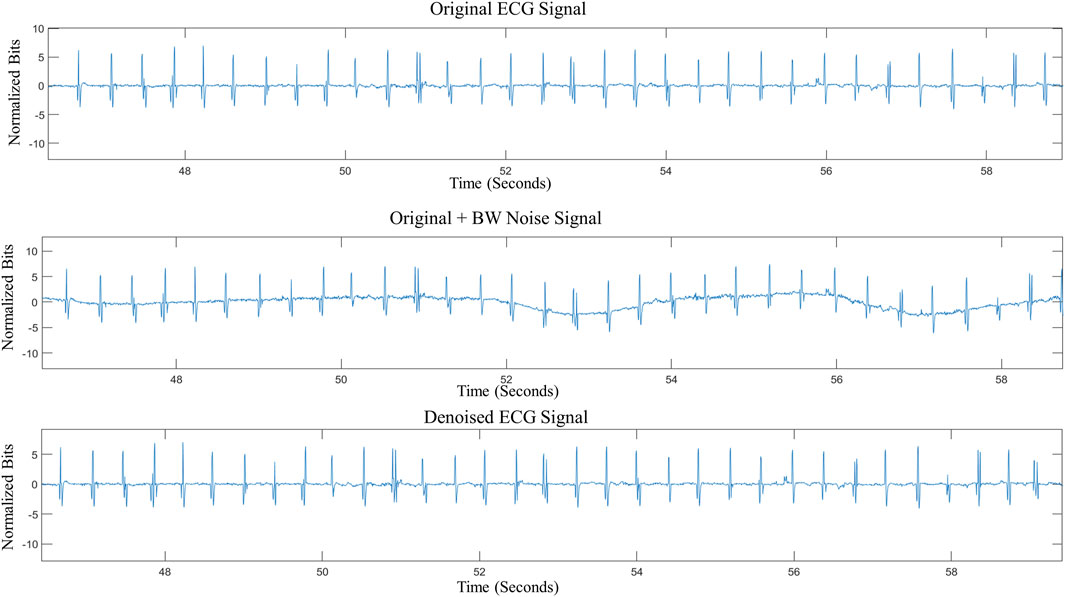- Signal Analysis Research Group, Department of Electrical, Computer, and Biomedical Engineering, Toronto Metropolitan University, Toronto, ON, Canada
Neonatal electrocardiogram (ECG) monitoring is an important diagnostic tool for identifying cardiac issues in infants at birth. Long-term remote neonatal dry-electrode ECG monitoring solutions can be an additional step for preventive healthcare measures. In these solutions, power and computationally efficient embedded signal processing techniques for denoising newborn ECGs can assist in increasing neonatal medical wearable time. Wavelet denoising is an appropriate denoising mechanism with low computational complexity that can be implemented on embedded microcontrollers for long-term remote ECG monitoring. Discrete wavelet transform (DWT) denoising for neonatal dry-electrode ECG using different wavelet families is investigated. The wavelet families and mother wavelets used include Daubechies (db1, db2, db3, db4, and db6), symlets (sym5), and coiflets (coif5). Different levels of added white Gaussian noise (AWGN) were added to 19 newborn ECG signals, and denoising was performed to select the appropriate wavelets for neonatal dry-electrode ECG. The selected wavelets then undergo real noise additions of baseline wander and electrode motion to determine their robustness and accuracy. Signal-to-noise ratio (SNR), mean squared error (MSE), and power spectral density (PSD) are used to examine denoising performance. db1, db2, and db3 wavelets are eliminated from analysis where the 30 dB AWGN led to negative SNR improvement for at least one newborn ECG, removing important ECG information. db4 and sym5 are eliminated from selection due to their different waveform morphology compared to the dry-electrode newborn ECG’s QRS complex. db6 and coif5 are selected due to their highest SNR improvement and lowest MSE of 6.26 × 10−6 and 1.65 × 10−7 compared to other wavelets, respectively. Their wavelet shapes are more like a newborn ECG’s QRS morphology, validating their selection. db6 and coif5 showed similar denoising performance, decreasing electrode motion and baseline wander noisy ECG signals by 10 dB and 14 dB, respectively. Further denoising of inherent dry-electrode noise is observed. DWT with coif5 or db6 wavelets is appropriate for denoising newborn dry-electrode ECGs for long-term neonatal dry-electrode ECG monitoring solutions under different noise types. Their similarity to newborn dry-electrode ECGs yields accurate and robust reconstructed denoised newborn dry-electrode ECG signals.
1 Introduction
ECGs measure the electrical activity of the heart. Clinically, ECGs are used to diagnose cardiac health and help physicians identify underlying heart problems. Abnormal electrical activity, such as atrial fibrillation and different types of tachycardias and bradycardias, can be identified through an ECG. In preventive healthcare, further ECG diagnosis can yield the recognition of risk factors and assist in assessing the overall health of the person’s cardiovascular health (Harskamp, 2019). In turn, physicians can use the information to recommend patient-specific treatment plans and lifestyle alterations. Currently, 12-lead ECG is the gold standard for such diagnoses. It uses 10 electrodes placed in different locations on the body to robustly monitor the electrical conduction activity from different angles and provide an accurate assessment. The disadvantages of 12-lead ECG include multiple electrodes, wires, and monitoring equipment unsuitable for intensive care units and remote long-term monitoring applications. These issues lead researchers to explore single-lead ECG and develop technological approaches that include investigating different types of dry electrodes and power-efficient signal processing techniques and designing single-lead monitoring systems that are comfortable, power-efficient, robust, clinically accurate with a small form factor for remote monitoring for preventive healthcare (Sun et al., 2015; Arquilla, Webb, and Anderson, 2020; Shao et al., 2020; Abdou and Krishnan, 2022). Single-lead ECG is an increasingly used diagnostic tool in day-to-day activities for monitoring post-operative patients for risk and assessing surgical success (Yong et al., 2016).
Cardiac health monitoring in newborns is a growing research field. After birth, newborns who are below a certain gestation period undergo neonatal intensive care, and 3-lead ECG systems are placed for constant cardiac monitoring in a clinical setting. Within 24 h of birth, clinical assessments using the 3-lead ECG information are performed by physicians, and treatment plans, if required, are developed. Based on the findings, the physician may discharge the patient and monitor their progress through regular check-ups. Remote ECG monitoring for newborns can be an important addition to the preventive healthcare measures for at-risk babies. An example of its importance is the prevention of sudden cardiac arrest in newborns with long QT syndrome (Saul et al., 2014; Brockmeier, Nazal, and Sreeram, 2016). Multiple technologies are being developed for newborn remote long-term monitoring applications utilizing ECG and other vital signs such as respiratory activity and temperature (Aviles-Espinosa et al., 2019; Fraiwan et al., 2009; Taylor et al., 2022; Lin et al., 2019; Anton et al., 2022; Henry et al., 2021).
An important aspect of long-term monitoring solutions is the deployment of power-efficient, real-time signal processing techniques for embedded microcontrollers (Health Quality Ontario, 2017; Alizadeh-Meghrazi et al., 2021; Abdou and Krishnan, 2022), especially for single-lead ECG signal acquisition devices with a continual operation time of 14+ days. More specifically, the development of embedded signal denoising techniques can assist in increasing the lifetime of medical wearables. Many researchers have examined different denoising approaches that are suitable for remote monitoring solutions. Many denoising techniques are proposed, including wavelet, empirical mode decomposition (EMD), sparsity, adaptive, deep learning, and hybrid-based models (Tripathi et al., 2021). The most prominent denoising model for real-time signal denoising revolves around wavelet and adaptive filtering models due to their embedded-friendly architecture and high power efficiency. These models contain a low computational complexity factor
Azzouz et al. (2024) developed a particle swarm optimization technique for wavelet parameter selection combined with wavelet transform to produce an ECG denoising algorithm. Their technique is able to denoise ECG signals obtained from the MIT-BIH Arrhythmia database, resulting in an increase of 17 dB in SNR, and can eliminate AWGN and power line interference (PLI) (Azzouz et al., 2024). The technique shows promise for the Internet of Medical Things (IoMT) due to its efficiency but lacks a newborn ECG application. Zhang et al. (2020) examined empirical mode decomposition, sample entropy, and a proposed threshold function implemented on the MIT-BIH Arrhythmia database. Their work yielded improved SNR and low MSE results. However, the application of EMD makes this process unsuitable for real-time signal denoising.
Cuomo et al., 2016 developed a recursive filtering technique for real-time ECG signal denoising. Their process utilized local denoising, which allows for real-time visualization. Their work is examined on Physionet’s long-term ST database. They investigated the execution time and memory usage of their algorithm, showing real-time capabilities (Cuomo et al., 2016). However, the work was deployed on a CPU-based architecture and not on an embedded microcontroller device. Tripathi et al. (2022) used a Fourier decomposition method utilizing discrete cosine transform (DCT). Their method has been implemented on the MIT-BIH Arrhythmia and Noise Stress Test databases and real-time ECG information. Their work yielded improved SNR and low percent root mean square difference (PRD) values.
Singh et al. explored DWT for denoising ECG using different wavelet families, including Daubechies, symlets, coiflets, and bio-orthogonals, in combination with non-local means (NLM) (Singh, Pradhan, and S. 2017). Their work used the MIT-BIH Arrhythmia database and utilized AWGN as the added noise for determining the denoising performance of the above-mentioned wavelet families before deciding on symlet 7 as the candidate to be combined with NLM. It is important to note that the db and coif wavelet families showed competitive results when compared to symlets, indicating that all three wavelet families may work for denoising ECG signals (Singh, Pradhan, and S. 2017). Their proposed DWT and NLM techniques showed high SNR improvement and low MSE and PRD performance metrics (Singh, Pradhan, and S. 2017). Further analysis of the computational cost of their algorithm is conducted.
Dore et al. (2022) developed an electric potential sensor-based real-time neonatal heart rate (HR) system using a field programmable gate array (FPGA). The authors deployed a 50-Hz notch filter and a 200-Hz low-pass filter on the FPGA to denoise the acquired ECG signals. Their work used the preterm infant cardio-respiratory signals database (PICSDB) and broadcast the signals through a phantom to examine their sensors and FPGA. The authors were able to reduce 50 Hz noise by an average of 30 dB and provide clean ECG signals (Dore et al., 2022). Their work did not explore other denoising techniques, as the focus of the work was on the implementation of a new sensor system for neonatal HR detection.
Mason et al. (2024) created a pipeline for infant HR extraction from their ECGs. The authors developed the pipeline using open-source pre-processing and R-peak detection algorithms that utilize low-pass, high-pass, band-pass, and EMD-based filtering approaches. They used a variety of fifth-order Butterworth band-pass and high-pass filters before R-peak detection. In addition, they further added beat correction algorithms to their pipeline to mitigate inaccuracies in R-peak detection due to noisy ECG signals. They tested their work on three infant datasets with an average infant age of 16.9 months, 8.5 months, and 7.3 months (Mason et al., 2024). The authors concluded that their pipeline is suitable for infant HR extraction (Mason et al., 2024). However, their work solely used open-source tools, such as neurokit2, which contain pre-defined filtering techniques, limiting the scope of the work to tools that may not consider recent advances in ECG denoising techniques. Furthermore, the work does not include denoising testing against predetermined AWGN, PLI, baseline wander (BW), or electrode motion (EM) noises that can provide a robust view of the denoising performances of the algorithms.
Arvinti et al. (2021) developed an algorithmic approach for preterm infant cardiac monitoring and bradycardia detection in neonates. They utilized wavelet decomposition to eliminate present BW and denoise ECG signals obtained from PICSDB, a dataset containing information from 10 preterm infants with an average gestational age of approximately 31 weeks and weight of 1,468 g (Gee et al., 2017). The authors utilized hard thresholding and Daubechies mother wavelets for their approach. Their results included an increase in average SNR of 4.2 dB, and they were able to create a system for detecting bradycardia based on R-R interval information (Arvinti et al., 2021). However, the authors did not examine pre-determined AWGN, PLI, BW, and EM noise, nor did the results include PSD information showing denoising performance. Other examined techniques are shown in Table 1.
An evident gap in denoising ECG research is the lack of investigative studies in dry-electrode ECG denoising, more specifically, newborn dry-electrode ECG for remote monitoring applications. To date, a research community-accepted wavelet-based denoising approach for neonatal ECG is missing. This study will explore the DWT denoising techniques and multiple wavelet families, including Daubechies, symlets, and coiflets. The work will utilize newborn single-lead ECGs acquired through 3D-printed dry electrodes. AWGN, EM, and BW will be added as noise components to create noisy ECG signals. The noisy signals will undergo DWT denoising, and candidate wavelets will be identified visually and through objective metrics, including SNR, MSE, and PSD.
The article is structured as follows. Section 2 will propose the approach for investigating wavelets and provide a brief overview of the SAR-NE dataset used in this study. Section 3 will provide the overall results of the study, including SNR improvement and MSE data. PSD information will be provided for EM and BW noisy ECG signals and their reconstructed/denoised versions. In addition, R-R interval and HR information pertaining to the denoising performance of selected wavelets will be provided. Section 4 will discuss the study outcomes and provide future steps in the investigation of other ECG denoising methods, such as adaptive filtering for real-time newborn ECG monitoring using dry electrodes. Section 5 will conclude the work.
2 Methods
2.1 SAR-NE dataset
Single-lead ECGs (3-min duration) from 19 newborns with a mean gestational age of 37.9 ± 1.3 weeks and mean weight of 2955 ± 740.5 g were collected using a handheld HR detector prototype that utilizes 3D-printed PLA-based dry electrodes (Abdou et al., 2023). The detector was placed directly on the chest, closest to the heart, in a lead-I configuration. The acquired ECGs and HR information were obtained from healthy newborns with no cardiac issues or present physical deformities that made device placement inaccessible (Abdou et al., 2023). The dataset was formulated from a community hospital servicing a diverse population. The ECGs were sampled at 500 Hz with 12-bit resolution and underwent 3–48 Hz band-pass filtering for HR and heart rate variability analysis. A zoomed-in normalized neonatal ECG is shown in Figure 1 where the QRS morphology is apparent, but P- and T-waves are not clear.
2.2 Wavelet denoising
Wavelet denoising is performed on the newborn ECGs in combination with different types of synthetic noise. AWGN is used to validate wavelet denoising and determine the most appropriate wavelets for denoising the original single-lead dry-electrode ECG signals, as shown in Figure 2. MSE and SNR improvement metrics are utilized for wavelet denoising performance. PSD is utilized to identify the impact of wavelet denoising on the original neonatal ECGs in removing EM and BW noise.
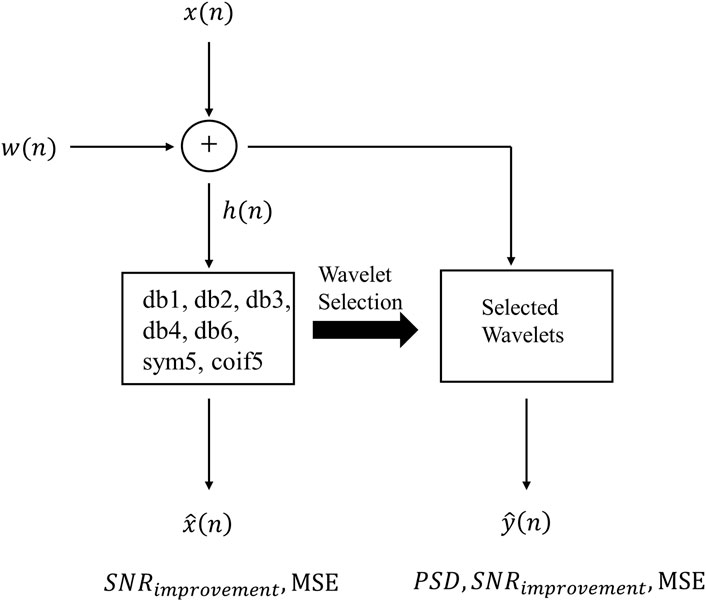
Figure 2. Proposed denoising examination methodology where
The wavelet families used in this study include a symlet, a coiflet, and several Daubechies wavelets. More specifically, Daubechies wavelets (db1, db2, db3, db4, and db6), symlet (sym5), and coiflet (coif5) are examined, as shown in Figure 2. These wavelet families are examined due to their robustness in ECG denoising in previous literature (Poornachandra, 2008; Samann and Schanze, 2019; Zhang et al., 2019; Azzouz et al., 2024). Furthermore, the wavelet families mentioned above provide practicability due to their identifiable number of vanishing moments, orthogonality, and near-symmetrical behaviors (Rashid et al., 2020). The db1, db2, and db3 Daubechies mother wavelets are examined to determine whether denoising performance improves with increased vanishing moments in the Daubechies family. db4, db6, sym5, and coif5 are chosen empirically due to their visual similarity to the QRS complexes in this ECG dataset, as shown in Figure 3. The choice of the above wavelets considers the DWT implementation capabilities in real-time denoising on embedded microcontrollers for IoMT and remote neonatal monitoring applications.

Figure 3. QRS and mother wavelet similarity: (A) Acquired newborn ECG QRS waveforms, and (B) mother wavelets for db4, db6, coif5, and sym5.
The decomposition levels are controlled across denoising processes with three decomposition levels. Three decomposition levels are appropriate to separate high- and low-frequency noise, such as PLI, EM, and BW. PLI and AWGN noises appear in the first two decomposition levels for ECG denoising paradigms, as presented in previous literature (Bodile and Talari, 2021; Azzouz et al., 2023). BW and EM noises were experimentally identified as being present in a minimum decomposition level 3 and higher. Note that three decomposition levels are chosen to provide the minimum number of levels required to separate noise while complying with the focus of implementing real-time DWT for ECG denoising on microcontrollers. In contrast, the thresholding methodology varies between soft and hard thresholding to determine the best-performing thresholding type that can provide reliable and robust outcomes and can be deployed in an embedded hardware architecture. Soft thresholding, as shown in Eq. 1, is defined as the shrinkage of certain wavelet coefficients with a scaling factor that ranges from 0 <
where
Hard thresholding is defined as the removal of certain detail coefficients where the coefficients identified above the threshold are scaled with a factor of
Newborn ECG and AWGN are added to determine the wavelet denoising performance in terms of
MSE is defined as the average of the summation of the squared difference between the original and reconstructed signals, as shown in Eq. 3. Small MSE values represent a higher similarity approximation between
2.3 Wavelet validation
The AWGN features different power magnifications: 25 dB, 20 dB, 15 dB, 10 dB, 5 dB, 0 dB, −5 dB, and −10 dB. EM and BW noises are obtained from the MIT-BIH noise stress database, which features 30-min adult ECG noise recordings with varying amplitudes sampled at 360 Hz for EM, BW, and electromyogram noises (Moody et al., 1992). In this case, EM and BW noises will be used to test the applicability of different wavelets in real-world noise signals. The noise signals are directly added to the newborn ECG signals, as represented in Eq. 4.
where
It is important to note that adult wet electrode EM noise from the MIT-BIH Noise Stress Test database may not be suitable for neonatal dry-electrode ECGs, which acts as a limitation to this examination. It is also important to note that the neonatal dry-electrode ECGs contain EM artifacts and some electromagnetic interference leakage. The newborn ECGs are assumed to be clean in order to examine the wavelet denoising algorithms.
R-peak detection is performed to further ensure wavelet denoising validation for clinical relevance, and R-R intervals are estimated for the clean, BW-added, and EM-added newborn ECG signals. These signals will be compared to the wavelet-denoised ECG signals’ R-R interval estimation to determine the robustness and accuracy in identifying important cardiac information for HR and HRV calculations. R-R intervals and HR estimations are calculated using a fixed threshold for minimal R-peak detection distance where detected peaks cannot be less than 200 ms apart (Yun et al., 2022). A comparative analysis between the proposed work and previous denoising techniques used for neonatal ECG enhancement is provided.
3 Results
All denoising techniques showed an average linear increase in
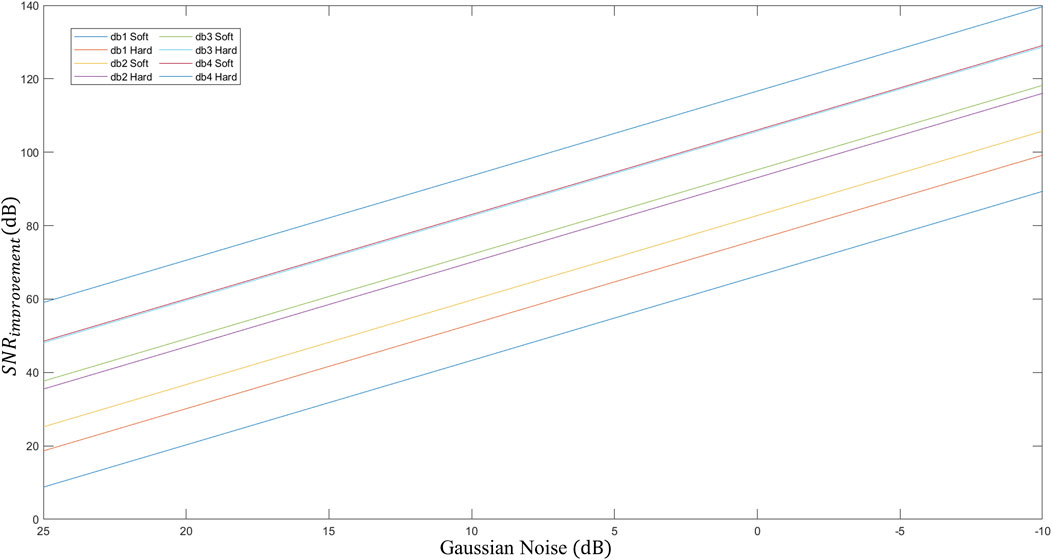
Figure 4.
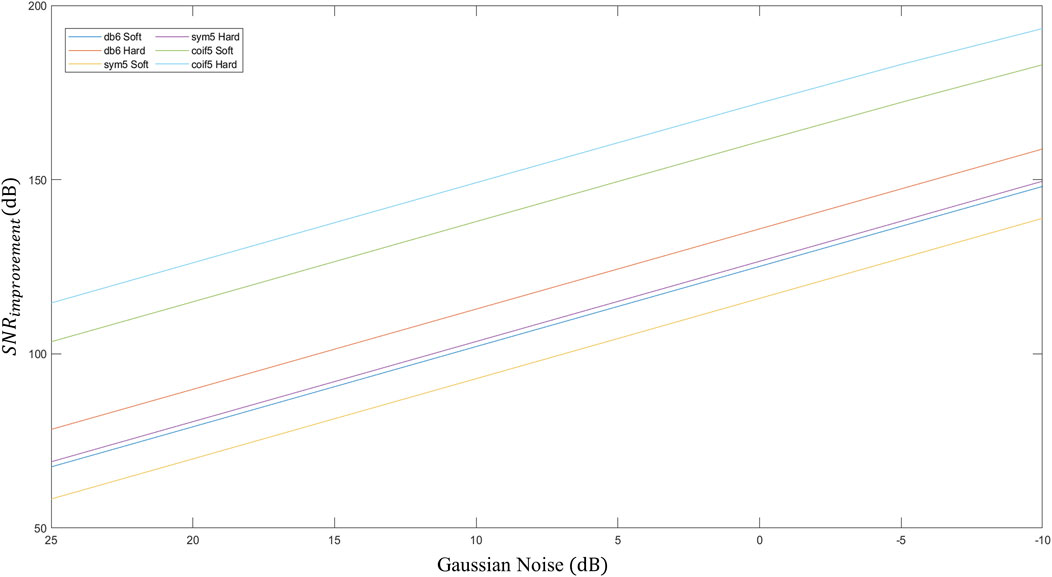
Figure 5.
The MSE values for db1, db2, db3, db4, db6, sym5, and coif5 soft thresholding are 2.28 × 10−3, 5.76 × 10−4, 1.93 × 10−4, 7.14 × 10−5, 1.15 × 10−5, 2.79 × 10−5, and 3.2 × 10−7, respectively, for the AWGN. The MSE values for db1, db2, db3, db4, db6, sym5, and coif5 hard thresholds are 9.49 × 10−4, 2.45 × 10−4, 9.05 × 10−5, 3.68 × 10−5, 6.26 × 10−6, 1.5 × 10−5, and 1.64 × 10−7, respectively.
The db4 hard threshold showed the smallest MSE value of 3.68 × 10−5, which is statistically significant (p < 0.05) compared to db1, db2, and db3. The db1 soft threshold showed the highest MSE of all denoising techniques with a value of 2.3 × 10−3. db4, db6, sym5, and coif5 produce MSE values that are all significantly different from one another with p < 0.05. The smallest MSE of 1.65 × 10−7 is provided by the coif5 hard threshold, which is statistically significant (p < 0.05) compared to the other denoising techniques and their thresholds. This value is approximately 38 times lower than that of db6 hard, with an MSE of 6.26 × 10−6, which is the second lowest MSE.
3.1 Wavelet selection
Based on the denoising performance analysis with the AWGN, the specified wavelets, db6 and coif5, are identified as reliable candidates for denoising neonatal dry-electrode-based ECGs with added EM and BW noise. These wavelets showed overall promise with their high
However, significant changes in noise type removal are evident in their respective PSDs. A small subset of newborn ECGs is used to show the difference in noise removal on EM- and BW-type noises. For both db6 and coif5 hard thresholds, EM noise is evidently removed, as shown in Figure 6 where the denoised newborn ECGs showed lower power in dB than the noisy signals. The substantial noise removed around the 3–27 Hz range across all three subjects contains important QRS information for HR determination. On the other hand, BW noise is removed for both db6 and coif5 hard thresholds, as shown in Figure 7. BW of 1 Hz has been removed in the reconstructed signals. BW noise reduction appears to occur in the first few Hz of the signal. Both db6 and coif5 showed an MSE value of 1 for denoising BW noise. Coif5 denoising produces an approximate newborn ECG signal for both EM and BW noises, as shown in Figures 8, 9 for Subject 14, respectively.
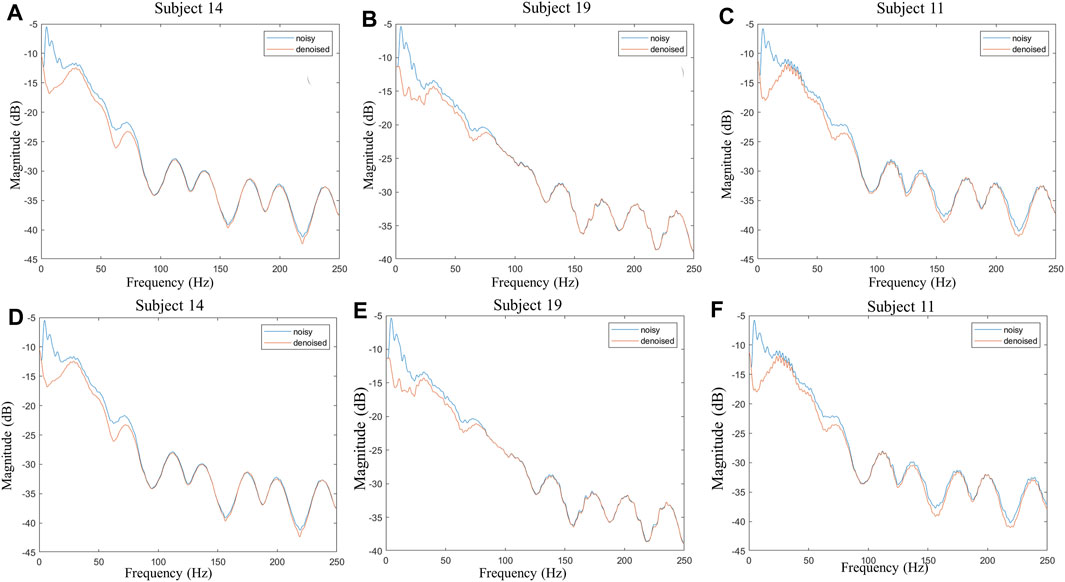
Figure 6. Three subjects’ PSD plots (A–C) for db6 and (D–F) for coif5 hard thresholding in denoising EM.
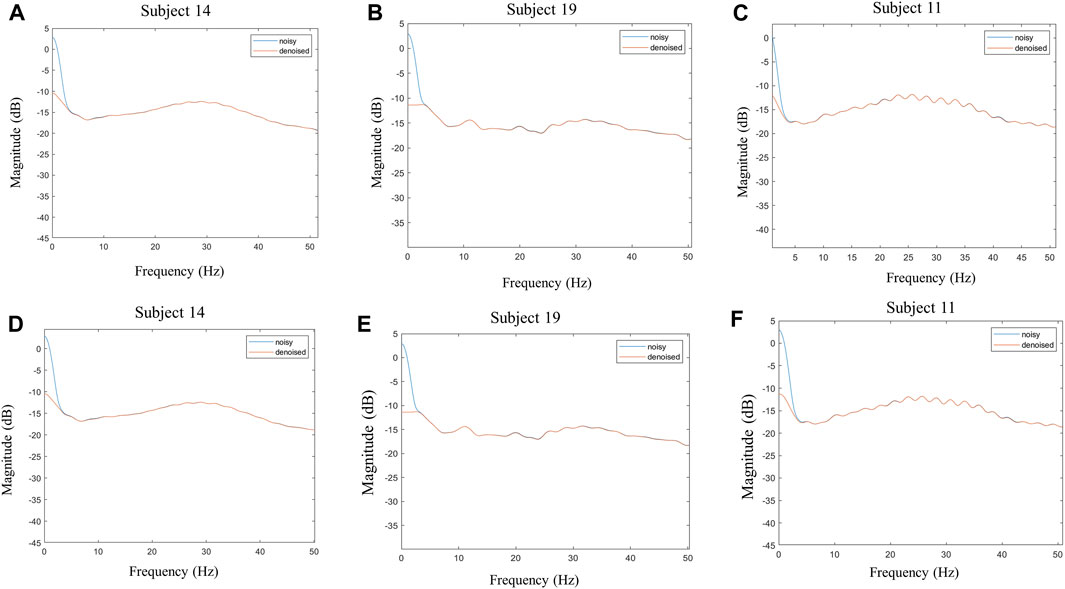
Figure 7. Three subjects’ PSD plots (A–C) for db6 and (D–F) for coif5 hard thresholding in denoising BW.
R-R interval and HR estimations are provided for both db6 and coif5 in Table 2. db6 and coif5 showed similar denoising performance for BW noisy ECG signals where the differences between original and denoised versions are 2.00 × 10−3 ms and 1 BPM for averaged R-R intervals and HR, respectively. For EM noisy ECG signals, db6 and coif5 provided denoised signals with higher HR, 156 BPM, and lower R-R intervals, 0.384 ms, than the original signals, as shown in Table 2. Table 3 offers a comparative view of the different denoising techniques presented in neonatal ECG enhancement. Our proposed work is compared to techniques utilizing fixed and adaptive filtering and DWT-based paradigms. Previous literature in neonatal ECG denoising does not focus on investigating different types of noises, such as the AWGN, and solely explores the application of denoising techniques for sensor development and/or obtaining certain clinical information, such as bradycardia detection, as shown in Table 3.
4 Discussion
4.1 Validation performance
DWT denoising is performed on 19 newborn ECGs with the goal of identifying the appropriate wavelet and thresholding techniques for denoising different types of noise. All newborn ECGs underwent the AWGN, resulting in noisy signals ranging in noise levels from 25 dB to −10 dB. The signals are later denoised/reconstructed using db1, db2, db3, db4, db6, sym5, and coif5 with either a soft or hard threshold methodology. This process yielded a linear increase in denoising performance represented in
4.2 EM and BW noise removal performance
The selected wavelets for EM and BW noise are db6 and coif5. Sym5 and db4 are eliminated due to the lack of visually similar mother wavelets with the acquired dry-electrode ECG signals. db6 and coif5 showed similar QRS morphology to the signals, where the similarity is entailed in the high zero crossing rate of the newborn signals, which is obvious due to the use of dry electrodes and a narrowed QRS complex that provides evidence of higher HRs in newborns. Both db6 and coif5 showed approximate PSDs and MSE values. coif5 and db6 yielded similar denoising performance as shown in Figures 8, 9. PSD plots for a sample of newborn ECG signals show the elimination of EM artifacts where overall noise removal mainly occurred in the range of 3–72 Hz, as shown in Figure 6. It is important to note that added significant EM noise is only present between 1 Hz and 10 Hz. EM noise is featured prominently in that range where the maximum decrease in the noisy and denoised signal power is approximately 10 dB at 4 Hz, while the minimum decrease of 7.5 dB occurred at 10 Hz. It is important to note that EM noise underwent 3–48 band-pass filtering that aligns with the signal acquisition, thus eliminating any EM noise below 3 Hz. The other range of removed noise from 10 Hz to 72 Hz can be attributed to dry-electrode inherent noise that occurs due to the lack of a gel layer for decreasing electrical impedance, creating jagged peaks in the assumed-clean ECG. Above 48 Hz, further attenuation of electromagnetic interference noise present in the original signal can be observed. The denoised reconstructed signal still maintained a high similarity to the original signal, as shown in Figure 8, where QRS waveforms are clearly present. However, MSE values for coif5 and db6 are higher than WGN-removal MSE values. This concept shows MSE limitation in identifying similarities between denoised and original signals when real noise that contains a non-zero variance and is non-stationary is added. MSE is sensitive to outliers found in the inherent noise of dry-electrode ECGs. Overall, DWT denoising using the selected wavelets is significant for EM noise removal in the 3 Hz–10 Hz, as shown in Figure 6. Due to mother wavelet similarity and QRS waveforms, coif5 and db6 are appropriate DWT wavelets for denoising added EM noise and some inherent dry-electrode ECG noise from newborn dry-electrode ECGs. However, the R-R interval and HR estimations reveal an average difference increase of 5 BPM from the original signals’ average HR. This concept shows that the denoised signals may still contain some EM noise that is considered in the elevated HR and lowered R-R interval calculations, as shown in Table 2.
BW is noted to be present in the 0–1 Hz frequency range. coif5 and db6 showed high denoising performance in eliminating BW noise. Note that BW will be removed in the original ECG signals due to the band-pass filtering ranging from 3 to 48 Hz, eliminating BW completely and partially eliminating EM noise. However, BW noise is added, without filtering, in the above range to examine the denoising performance of coif5 and db6. BW noise removal is shown to be eliminated where 0.25 Hz noise power decreases by 14.1 dB, whereas 1 Hz BW noise drops by 12 dB, as shown in Figure 9. These results show the effectiveness of eliminating BW noise added to newborn ECGs. The significance relies on DWT’s performance in identifying low-frequency information using coif5 and db6. Both wavelets are appropriate for eliminating EM and BW noise present in ECG information. DWT with coif5 and db6 has shown to perform well with the above-mentioned noise. Other noise removal occurs throughout the signals, as shown in the PSD plots. The signals are assumed to be clean but may contain further random spikes that are being removed during the denoising process, yielding a clear, robust signal for QRS detection and HR estimation algorithms. The differences between coif5 and db6 are visually minor, which explains their similar denoising performance. It is evident that coif5 and db6 are suitable for denoising newborn dry-electrode ECGs. DWT with coif5 or db6 can be used in denoising neonatal dry-electrode ECGs that contain EM or BW noise. By eliminating ECG noise in a signal processing step, cardiac information such as QRS complexes or R-peaks can be clearly identified, which in turn can be used in accurately determining surrogate information such as HR, HRV, and improved real-time arrhythmia detection.
DWT is becoming a prominent denoising technique for denoising neonatal ECGs. However, other techniques show good results that should be further examined, as shown in Table 3. Most neonatal ECG denoising techniques offer a big O notation of O(N), a metric used to determine operational complexity, except for the fixed filtering approach. Compared to previous literature, our proposed work provides an objective, holistic framework in investigating DWT for neonatal dry-electrode ECG denoising where different noise types are added to ECGs and examined under MSE, SNR, and clinically relevant features such as HR and R-R intervals. Furthermore, algorithmic complexity is provided to relay its applicability on embedded microcontrollers. It is obvious that most denoising techniques for neonatal ECGs are feasible in real-time microcontroller deployment where O(N) operation is realizable. Further embedded-friendly filtering techniques should be examined to determine the most appropriate process for denoising newborn dry-electrode ECGs. Other denoising techniques that should be explored include adaptive filtering processes such as Savitzky–Golay and recursive least squares filtering. In addition, other future directions in neonatal ECG denoising should focus on determining power requirements and real-application investigation of the above-mentioned techniques through microcontroller deployment. This work is an investigation of DWT as a tool in denoising newborn dry-electrode ECGs and should be further investigated to include other denoising techniques, different number of levels for wavelet decomposition, DWT’s microcontroller deployment feasibility, applicability in multi-lead neonatal ECG monitoring, and their general role in obtaining clinically relevant features like HR and HRV for diagnostic purposes such as neonatal arrhythmia detection and remote, long-term, neonatal post-operative cardiac monitoring.
5 Conclusion
Wavelet denoising is a pre-processing step in denoising the ECG signals. DWT is determined for its computational and power efficiency metrics and its applicability in IoMT for remote, long-term, newborn single-lead ECG monitoring applications using dry electrodes. DWT can be deployed directly on microcontrollers, making it suitable for the above-mentioned applications. In this study, we explored DWT with multiple wavelet families, including Daubechies, symlets, and coiflets. Decomposition levels are controlled to three levels, whereas thresholding varies between soft and hard thresholding techniques. The mother wavelets determined for denoising are db1, db2, db3, db4, db6, sym5, and coif5. WGN is added to 19 newborn ECG signals, and denoising is performed to validate DWT as a modality for denoising dry-electrode ECGs. SNR improvements and MSE are used as metrics to determine DWT validity. Following this process, db1, db2, and db3 are eliminated due to their removal of important newborn ECG information when at least one newborn signal showed a decrease in SNR improvement at 30 dB WGN and high MSE values. The db4 and sym5 mother wavelets did not show similarities to the newborn ECG QRS complex, further eliminating them from the added BW and EM noise denoising analysis. db6 and coif5 are used in denoising and show approximate PSD plots and MSE values. Both showed similar QRS morphology to the present newborn ECGs, making them the appropriate wavelets for denoising purposes. They performed similarly and yielded denoised reconstructed ECG signals similar to the original ECGs.
Data availability statement
The data analyzed in this study are subject to the following licenses/restrictions: The dataset and its results are currently being curated for a full study and will become available in Q4 2024. Requests to access this dataset should be directed to YWJkZWxyYWhtYW4uYWJkb3VAdG9yb250b211LmNh.
Ethics statement
The studies involving humans were approved by the Toronto Metropolitan University. The studies were conducted in accordance with the local legislation and institutional requirements. Written informed consent for participation in this study was provided by the participants’ legal guardians/next of kin.
Author contributions
AA: conceptualization, data curation, formal analysis, investigation, methodology, resources, visualization, and writing–original draft. SK: conceptualization, funding acquisition, methodology, project administration, resources, supervision, visualization, and writing–review and editing.
Funding
The author(s) declare that financial support was received for the research, authorship, and/or publication of this article from the Natural Sciences and Engineering Research Council (NSERC), Canada, and Toronto Metropolitan University, Canada.
Acknowledgments
We gratefully acknowledge the advice provided by our clinical and international collaborators in signal processing.
Conflict of interest
The authors declare that the research was conducted in the absence of any commercial or financial relationships that could be construed as a potential conflict of interest.
The author(s) declared that they were an editorial board member of Frontiers, at the time of submission. This had no impact on the peer review process and the final decision.
Publisher’s note
All claims expressed in this article are solely those of the authors and do not necessarily represent those of their affiliated organizations, or those of the publisher, the editors and the reviewers. Any product that may be evaluated in this article, or claim that may be made by its manufacturer, is not guaranteed or endorsed by the publisher.
References
Abdou, A., and Krishnan, S. (2022). Horizons in single-lead ECG analysis from devices to data. Front. Signal Process. 2 (April), 866047. doi:10.3389/frsip.2022.866047
Abdou, A., Krishnan, S., and Mistry, N. (2023). Evaluating a novel infant heart rate detector for neonatal resuscitation efforts: protocol for a proof-of-concept study. JMIR Res. Protoc. 12 (October), e45512. doi:10.2196/45512
Alizadeh-Meghrazi, M., Ying, B., Schlums, A., Lam, E., Eskandarian, L., Abbas, F., et al. (2021). Evaluation of dry textile electrodes for long-term electrocardiographic monitoring. Biomed. Eng. OnLine 20 (1), 68. doi:10.1186/s12938-021-00905-4
Anton, O., Dore, H., Rendon-Morales, E., Aviles-Espinosa, R., Seddon, P., Wertheim, D., et al. (2022). Non-invasive sensor methods used in monitoring newborn babies after birth, a clinical perspective. Maternal Health, Neonatol. Perinatology 8 (1), 9. doi:10.1186/s40748-022-00144-y
Arquilla, K., Webb, A. K., and Anderson, A. P. (2020). Textile electrocardiogram (ECG) electrodes for wearable health monitoring. Sensors Basel, Switz. 20 (4), 1013. doi:10.3390/s20041013
Arvinti, B., Iacob, E. R., Isar, A., Iacob, D., and Costache, M. (2021). Automated medical care: bradycardia detection and cardiac monitoring of preterm infants. Med. Kaunas. Lith. 57 (11), 1199. doi:10.3390/medicina57111199
Aviles-Espinosa, R., Dore, H., and Rendon-Morales, E. (2023). An experimental method for bio-signal denoising using unconventional sensors. Sensors Basel, Switz. 23 (7), 3527. doi:10.3390/s23073527
Aviles-Espinosa, R., Rendon-Morales, E., Luo, Z., Henry, D., Anton, O., Rabe, H., et al. (2019). “Neo-SENSE: a non-invasive smart sensing mattress for cardiac monitoring of babies,” in 2019 IEEE Sensors Applications Symposium (SAS), Sophia Antipolis, France, 11-13 March 2019.
Azzouz, A., Bengherbia, B., Wira, P., Alaoui, N., and Souahlia, A. (2023). The effectiveness of optimal discrete wavelet transform parameters obtained using the genetic algorithm for ECG signal denoising. Rev. d’Intelligence Artif. 37 (6), 1387–1396. doi:10.18280/ria.370602
Azzouz, A., Bengherbia, B., Wira, P., Alaoui, N., Souahlia, A., Mohamed, M., et al. (2024). An efficient ECG signals denoising technique based on the combination of particle swarm optimisation and wavelet transform. Heliyon 10 (5), e26171. doi:10.1016/j.heliyon.2024.e26171
Bodile, R. M., and Talari, V. K. H. R. (2021). Removal of power-line interference from ECG using decomposition methodologies and kalman filter framework: a comparative study. Trait. Du. Signal 38 (3), 875–881. doi:10.18280/ts.380334
Brockmeier, K., Nazal, R., and Sreeram, N. (2016). The electrocardiogram of the neonate and infant. J. Electrocardiol. 49 (6), 814–816. doi:10.1016/j.jelectrocard.2016.07.027
Chandrakar, C., and Sharma, M. (2014). “A real time approach for ECG signal denoising and smoothing using adaptive window technique,” in 2014 9th international conference on industrial and information systems (ICIIS) (Gwalior, India: IEEE), 1–6. doi:10.1109/ICIINFS.2014.7036632
Cuomo, S., De Pietro, G., Farina, R., Galletti, A., and Sannino, G. (2016). A revised scheme for real time ECG signal denoising based on recursive filtering. Biomed. Signal Process. Control 27 (May), 134–144. doi:10.1016/j.bspc.2016.02.007
Dore, H., Aviles-Espinosa, R., and Rendon-Morales, E. (2022). “FPGA implementation of ECG signal processing for use in a neonatal heart rate monitoring system,” in The 9th International Electronic Conference on Sensors and Applications (Basel, Switzerland: MDPI), 70.
Fraiwan, L., Al-Bataineh, O., Matouq, J., Haddad, S., and Bani-Amer, M. (2009). ECG-based wireless home infant apnoea monitor. J. Med. Eng. Technol. 33 (4), 309–313. doi:10.1080/03091900802565718
Gee, A. H., Barbieri, R., Paydarfar, D., and Indic, P. (2017). Predicting bradycardia in preterm infants using point process analysis of heart rate. IEEE Trans. Biomed. Eng. 64 (9), 2300–2308. doi:10.1109/TBME.2016.2632746
Harskamp, R. E. (2019). Electrocardiographic screening in primary care for cardiovascular disease risk and atrial fibrillation. Prim. Health Care Res. Dev. 20 (June), e101. doi:10.1017/S1463423619000355
Health Quality Ontario (2017). Long-term continuous ambulatory ECG monitors and external cardiac loop recorders for cardiac Arrhythmia: a health Technology assessment. Ont. Health Technol. Assess. Ser. 17 (1), 1–56.
Henry, C., Lara, S., Ward, C., Mirahmadi, S., Liu, C., Morgan, S., et al. (2021). Accurate neonatal heart rate monitoring using a new wireless, cap mounted device. Acta Paediatr. 110 (1), 72–78. doi:10.1111/apa.15303
Kachibhotla, S., and Mathur, S. (2009). “Multi resolution analysis of pediatric ECG signal,” in 13th international conference on biomedical engineering. Editors C. T. Lim, and J. C. H. Goh (Berlin, Heidelberg: Springer Berlin Heidelberg), 758–760. doi:10.1007/978-3-540-92841-6_186
Kumar, A., Tomar, H., Kumar Mehla, V., Komaragiri, R., and Kumar, M. (2021). Stationary wavelet transform based ECG signal denoising method. ISA Trans. 114 (August), 251–262. doi:10.1016/j.isatra.2020.12.029
Lin, H. J., Lan, Y.-T., Silka, M. J., Halnon, N. J., Villa-Lopez, E., Arenas, N., et al. (2019). Home use of a compact, 12-lead ECG recording system for newborns. J. Electrocardiol. 53, 89–94. doi:10.1016/j.jelectrocard.2019.01.086
Lin, H.-Y., Liang, S.-Y., Ho, Y.-L., Lin, Y.-H., and Ma, H.-P. (2014). Discrete-wavelet-transform-based noise removal and feature extraction for ECG signals. IRBM 35 (6), 351–361. doi:10.1016/j.irbm.2014.10.004
Mason, H. T., Martinez-Cedillo, A. P., Vuong, Q. C., Garcia-de-Soria, M. C., Smith, S., Geangu, E., et al. (2024). A complete pipeline for heart rate extraction from infant ECGs. Signals 5 (1), 118–146. doi:10.3390/signals5010007
Moody, G. B., Muldrow, W. E., and Mark, R. G. (1992) The MIT-BIH noise stress test database. [object Object]. doi:10.13026/C2HS3T
Poornachandra, S. (2008). Wavelet-based denoising using subband dependent threshold for ECG signals. Digit. Signal Process. 18 (1), 49–55. doi:10.1016/j.dsp.2007.09.006
Rashid, O., Amin, A., and Lone, M. R. (2020). “Performance analysis of DWT families,” in 2020 3rd international conference on intelligent sustainable systems (ICISS) (Thoothukudi, India: IEEE), 1457–1463. doi:10.1109/ICISS49785.2020.9315960
Samann, F., and Schanze, T. (2019). An efficient ECG denoising method using discrete wavelet with savitzky-golay filter. Curr. Dir. Biomed. Eng. 5 (1), 385–387. doi:10.1515/cdbme-2019-0097
Saul, J. P., Schwartz, P. J., Ackerman, M. J., and Triedman, J. K. (2014). Rationale and objectives for ECG screening in infancy. Heart Rhythm. 11 (12), 2316–2321. doi:10.1016/j.hrthm.2014.09.047
Shao, M., Zhou, Z., Bin, G., Bai, Y., and Wu, S. (2020). A wearable electrocardiogram telemonitoring system for atrial fibrillation detection. Sensors Basel, Switz. 20 (3), 606. doi:10.3390/s20030606
Singh, P., Pradhan, G., and Shahnawazuddin, S. (2017). Denoising of ECG signal by non-local estimation of approximation coefficients in DWT. Biocybern. Biomed. Eng. 37 (3), 599–610. doi:10.1016/j.bbe.2017.06.001
Sun, K., Zhang, S., Li, P., Xia, Y., Zhang, X., Du, D., et al. (2015). Review on application of PEDOTs and PEDOT:PSS in energy conversion and storage devices. J. Mater. Sci. Mater. Electron. 26 (7), 4438–4462. doi:10.1007/s10854-015-2895-5
Taylor, A. N., Warren, A. E., Parkash, R., and Dhillon, S. S. (2022). Using smartphone wireless ECG monitoring to provide symptom-rhythm correlation in the paediatric population. CJC Pediatr. Congenit. Heart Dis. 1 (3), 158–161. doi:10.1016/j.cjcpc.2022.04.002
Tripathi, P., Kumar, A., Komaragiri, R., and Kumar, M. (2022). A novel approach for real-time ECG signal denoising using fourier decomposition method. Res. Biomed. Eng. 38 (4), 1037–1049. doi:10.1007/s42600-022-00237-9
Tripathi, P. M., Kumar, A., Komaragiri, R., and Kumar, M. (2021). A review on computational methods for denoising and detecting ECG signals to detect cardiovascular diseases. Archives Comput. Methods Eng. 29, 1875–1914. doi:10.1007/s11831-021-09642-2
Vullings, R., Vries, B. D., and Bergmans, J. W. M. (2011). An adaptive kalman filter for ECG signal enhancement. IEEE Trans. Biomed. Eng. 58 (4), 1094–1103. doi:10.1109/TBME.2010.2099229
Yong, J. H. E., Thavorn, K., Hoch, J. S., Mamdani, M., Thorpe, K. E., Dorian, P., et al. (2016). Potential cost-effectiveness of ambulatory cardiac rhythm monitoring after cryptogenic stroke. Stroke 47 (9), 2380–2385. doi:10.1161/STROKEAHA.115.011979
Yun, D., Lee, H.-C., Jung, C.-W., Kwon, S., Lee, S.-R., Kim, K., et al. (2022). Robust R-peak detection in an electrocardiogram with stationary wavelet transformation and separable convolution. Sci. Rep. 12 (1), 19638. doi:10.1038/s41598-022-19495-9
Zhang, D., Wang, S., Li, F., Shang, T., Wang, J., Ding, X., et al. (2020). An efficient ECG denoising method based on empirical mode decomposition, sample entropy, and improved threshold function. Wirel. Commun. Mob. Comput. 2020 (2), 1–11. doi:10.1155/2020/8811962
Keywords: dry electrodes, single-lead, ECG, wavelet, denoising, newborn, heart rate
Citation: Abdou A and Krishnan S (2024) Enhancement of single-lead dry-electrode ECG through wavelet denoising. Front. Sig. Proc. 4:1396077. doi: 10.3389/frsip.2024.1396077
Received: 05 March 2024; Accepted: 23 April 2024;
Published: 28 May 2024.
Edited by:
Yunfeng Wu, Xiamen University, ChinaReviewed by:
Rishi Raj Sharma, Defence Institute of Advanced Technology (DIAT), IndiaJagannath M., Vellore Institute of Technology (VIT), India
Mahmoud Seifallahi, Florida Atlantic University, United States
Copyright © 2024 Abdou and Krishnan. This is an open-access article distributed under the terms of the Creative Commons Attribution License (CC BY). The use, distribution or reproduction in other forums is permitted, provided the original author(s) and the copyright owner(s) are credited and that the original publication in this journal is cited, in accordance with accepted academic practice. No use, distribution or reproduction is permitted which does not comply with these terms.
*Correspondence: Abdelrahman Abdou, YWJkZWxyYWhtYW4uYWJkb3VAdG9yb250b211LmNh
 Abdelrahman Abdou
Abdelrahman Abdou Sridhar Krishnan
Sridhar Krishnan